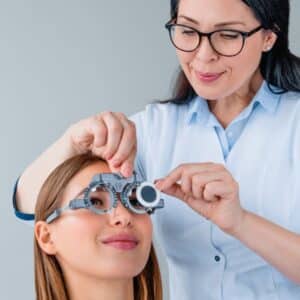Ophthalmalgia, the medical term for eye pain, refers to any discomfort or upsetting sensation in or around the eye. It is characterized by pain, ranging in intensity from moderate irritation to excruciating, severe discomfort.
Eye injuries, infections, inflammation, underlying medical disorders, foreign objects in the eye, and inflammation can all be causes of eye discomfort, which can be localized to the surface of the eye or may originate deeper within the eye.
Ocular discomfort can vary greatly in type and intensity, often accompanied by additional symptoms such as redness, tears, altered vision, or light sensitivity. A prompt evaluation by a medical practitioner or eye specialist is essential for identifying the source of eye pain and starting the proper therapy.
It is crucial to get medical help when experiencing eye discomfort because ignoring chronic or severe eye pain can have negative consequences, including vision issues.
Finding the pain points
Finding the precise spot in the eye where pain is coming from is essential to treating eye pain and figuring out what’s causing it. Understanding the structures involved and how they function will help you identify the source of your eye problems. Let’s examine these structures and learn how to locate the painful areas:
Cornea: The cornea is the eye’s clear, dome-shaped front surface. Its primary function is to direct light toward the retina. If your cornea is superficial and has a burning, scratchy, or foreign object sensation, it may be the source of your pain.
Sclera: The sclera, also known as the “white” of the eye, supports the eye’s structure and encircles the cornea. Sclera-related discomfort may appear to be a broad, widespread pain that permeates the entire eye.
Conjunctiva: Lining the interior of the eyelids and covering the sclera, the conjunctiva is a thin, transparent membrane. Irritation or inflammation of the conjunctiva can cause redness, itching, and a grainy feeling in the eye.
The iris is the colored area of the eye that houses the pupil’s center. Iritis and uveitis, two disorders that may be associated with iris pain, are less common. Deep-seated pain, pupil size changes, and light sensitivity are common symptoms.
The orbit is the bony eye socket in the skull that houses the eye and its muscles. If you have severe, deep-seated eye pain, it may be due to orbital structures. Optic neuritis and glaucoma accompany this pain.
The extraocular muscles are responsible for the eye’s rotation and movement. These muscles may cause discomfort when moving the eyes, which may be a sign of problems affecting the muscles’ ability to operate.
The transmission of visual information from the eye to the brain depends heavily on nerves. Optic neuritis, an inflammation or injury to the optic nerve, can cause pain, especially when moving the eyes laterally.
Eyelids: The eyelids shield the eye and aid in distributing moisture over the surface of the ocular organ. Eyelid pain may indicate the presence of sty (chalazion) or blepharitis.
Your healthcare provider or an eye specialist can greatly benefit from knowing the location of your eye pain and any accompanying symptoms. Having this information is crucial for making an informed diagnosis and creating a suitable treatment strategy. If you are unsure of the cause of your eye pain, or if it is severe and persistent, we strongly advise you to consult an eye doctor to protect your eye health and wellbeing.
Causes of Eye Pain
There are many different causes of eye pain, each with its own peculiarities and effects. Comprehending the fundamental reasons behind ocular discomfort is essential for precise identification and suitable remediation. Here, we go into greater detail about the common causes:
Foreign Object: The presence of foreign items in the eye is one of the most frequent causes of eye pain. Whether it’s a lash, a bit of dirt, or cosmetic particles, these irritants might cause discomfort. Redness, tears, and a feeling that something is in the eye are common symptoms.
Conjunctivitis, also known as “pink eye,” is an inflammation of the conjunctiva, the thin membrane that covers the white portion of the eye and the inside surface of the eyelids. It may be the result of allergies or infections, which can lead to redness, itching, discharge, and slight eye pain.
Contact Lens Irritation: Eye pain may result from improper contact lens care and usage. Wearing contact lenses for prolonged periods of time, failing to properly disinfect them, or sleeping with them can all lead to inflammation, infection, and pain.
Corneal Abrasion: A corneal abrasion is a scrape on the cornea, the transparent front surface of the eye responsible for focusing light. Different things could cause this kind of injury, such as accidentally touching your eyes or contact with foreign substances. Pain, light sensitivity, frequent tears, and the feeling that something is in the eye are all common symptoms of corneal abrasions.
Eye injuries, whether caused by chemical irritants or physical assault, can be extremely painful. Chemical burns and flash burns to the eye, frequently caused by exposure to bleach or strong light sources, can cause severe eye discomfort. Treat these injuries immediately.
Blepharitis occurs when the oil glands at the eyelid border become inflamed or infected. This illness can cause eye discomfort. This illness can cause eye discomfort. This illness can cause eye discomfort. This illness can cause eye discomfort. This illness can cause eye discomfort. In addition to symptoms such as redness, itching, and the impression of foreign objects in the eyes, this illness can cause discomfort in the eyes.
Sty: An infection or inflammation of an oil gland in the eyelid can result in the development of a sty, sometimes called a challenge. A challenge can cause a sore bulge on the eyelid, even though it usually doesn’t hurt.
Elevated intraocular pressure distinguishes a collection of eye disorders known as glaucoma. It may cause severe eye pain, particularly in cases of acute angle-closure glaucoma. Additional symptoms such as headache, nausea, and blurred vision may also occur. Acute angle-closure glaucoma is a medical emergency that requires immediate treatment to prevent blindness.
Optic neuritis: This condition entails inflammation of the optic nerve, which serves as a nerve ending that links the brain to the rear of the eye. This disorder can cause loss of vision and eye pain, especially when moving the eyes laterally. Optic neuritis may be associated with infections or autoimmune disorders.
Sinusitis: A sinus infection that puts pressure on the eyes and produces pain is known as sinusitis. One or both sides of the eyes may hurt, depending on where the sinus infection is located.
Eye pain is one of the most common migraine headache symptoms. Significant headache, nausea, and light sensitivity are some of the other typical migraine symptoms that can accompany significant eye pain.
Iritis: Deep-seated eye pain may be a symptom of iritis, or inflammation of the iris. Systemic illnesses, infections, or trauma.
To successfully address and manage this symptom, one must first understand the many causes of eye pain. The range of treatment options varies based on the underlying reason and includes both medical and home therapies. A timely evaluation by a specialist in eye care is necessary for the proper diagnosis and treatment planning.
Treatment for Eye Pain
We take into account the root cause and the severity of the problem. We use the following list of common treatments to address various eye-related issues:
At-Home Care:
Artificial Tears: Lubricating eye drops help relieve irritation and dryness. When it comes to moderate cases of eye irritation, they are especially beneficial.
Rest: You can relieve mild eye discomfort by resting your eyes, particularly after extended screen time or eye strain, can relieve mild eye discomfort.
Drugs:
To treat bacterial infections of the eyes, such as bacterial keratitis (corneal infection) or bacterial conjunctivitis (pink eye), physicians administer antibiotic eye drops or ointments.
We use antiviral drugs to treat herpes simplex keratitis and other viral eye infections.
Antihistamines: Eye drops or oral antihistamines can help reduce allergy-related ocular symptoms.
Corticosteroids: These anti-inflammatory medications can treat uveitis and iritis.
Warm Compress:
For blepharitis or sties, applying a warm wet compress to the afflicted eye can be beneficial. It promotes the discharge of clogged glands and eases discomfort.
Floshing:
To get rid of an irritant, it’s crucial to flush the eye with clean water or saline solution if a foreign object or chemical gets inside.
Oral Drugs:
Your doctor may occasionally recommend oral medications to treat underlying conditions, such as antibiotics for certain infections or painkillers for excruciating eye discomfort.
Surgical Procedures:
Corneal Abrasion Surgery: In rare cases, surgical repair may be required when conservative methods fail to heal deep corneal abrasions.
When medication and eye drops are insufficient to control glaucoma, surgeons may recommend surgical techniques to increase drainage and lower intraocular pressure.
Vision Adjustment:
Glasses or contact lenses are examples of vision correction techniques that can greatly enhance visual clarity and comfort for certain eye problems, such as refractive defects.
Specialized Care:
Laser Therapy: To reduce intraocular pressure and manage some eye disorders, such as glaucoma, laser therapy may be beneficial.
Injections: An ophthalmologist may recommend specific injections into the eye if there is severe inflammation in the eyes or macular degeneration.
Handling of Supporting Conditions:
It’s critical to treat underlying medical illnesses that aggravate eye issues. Comprehensive management may be necessary for conditions like diabetes, autoimmune illnesses, and systemic infections.
The particular diagnosis that an eye care doctor makes determines the course of treatment. Without expert supervision, self-diagnosis and therapy can be dangerous and worsen the issue. If you have any eye-related symptoms, such as vision changes or chronic or severe eye pain, seek immediate treatment from a healthcare practitioner or ophthalmologist. Appropriate and timely care can help maintain the health of your eyes, reduce discomfort, and avoid complications.
Eye Pain: Identifying Critical Circumstances
Even though at-home care or routine medical attention can treat the majority of cases, there are times when eye pain qualifies as a medical emergency. It is critical to promptly identify these emergency situations in order to avoid possible visual impairment or severe consequences. Keep an eye out for the following eye-related emergencies:
Sudden Vision Loss: You should get medical help right away if you suddenly and dramatically lose your ability to see in one or both of your eyes. Abrupt changes in vision could point to a serious underlying problem such as acute glaucoma, vascular occlusion, or retinal detachment.
Severe Eye Pain: If you experience persistent, intense eye pain that is not consistent with a little cut or irritation, you should be concerned. Serious corneal infections, acute glaucoma, or intraocular pressure spikes could indicate this degree of pain, necessitating immediate treatment.
Eye Trauma: Treat any serious eye injury as an emergency, regardless of the cause, such as chemical exposure, physical force, or foreign object. Refrain from touching or compressing the injured eye, and get medical help as soon as possible.
Chemical Exposure: If a chemical, such as industrial chemicals or domestic cleansers, gets in your eyes, you need to act quickly. Seek emergency medical attention and thoroughly rinse the injured eye for at least fifteen minutes with clean water or a saline solution.
The combination of severe eye discomfort, nausea, vomiting, and stomach pain may indicate acute angle-closure glaucoma, a systemic illness. You must seek immediate medical attention for this disease.
If the pain in your eyes is so severe that you can’t move or touch them without excruciating pain, you should declare an emergency. This degree of discomfort may be a sign of major infections, extreme inflammation, or other illnesses.
Rainbow-colored circles and light halos: If you experience severe eye pain and see halos or rainbow-colored circles around lights, you may have acute glaucoma and need immediate medical attention.
Foreign Body Embedded in the Eye: A medical emergency is indicated if a foreign object has entered the eye or embedded itself on its surface. Instead of attempting to remove it yourself, get professional assistance right away.
In any of these situations, it is imperative that you go to the nearest emergency department or seek immediate medical assistance from an eye care specialist. Seeking assistance as soon as possible can help prevent problems and irreversible visual loss. During these critical moments, it is critical to prioritize and protect your eyes’ health.
Keeping Your Vision Safe: Avoiding Eye Pain
It’s crucial to take preventative measures to keep your eyes healthy and avoid eye pain. By forming excellent eye care practices and lowering possible hazards, you can decrease the chance of developing eye discomfort and related issues. The following are practical methods for avoiding eye pain:
Put on safety goggles:
When participating in activities that may expose your eyes to flying debris, chemicals, or foreign objects, wear protective goggles or glasses. This covers things like playing sports, dealing with dangerous products, and woodworking.
Maintain Proper Contact Lens Care:
Follow your eye care specialist’s cleaning, maintenance, and lens replacement instructions if you wear contact lenses. While you sleep, only wear lenses designed for extended wear.
Limit the amount of time spent on screens.
The 20-20-20 rule can help you prevent digital eye strain: after 20 minutes, take a 20-second break and look at something 20 feet away to prevent digital gadget fatigue.
Make sure there’s adequate lighting.
Adequate illumination can reduce eye strain. When using a computer or reading, keep your eyes away from glare from windows or overhead lighting. We use task lighting to illuminate work spaces.
Blink Often:
Blinking, particularly when looking on a screen for extended periods of time, helps hydrate the eyes and avoid dryness. Try to remember to blink more frequently.
Use synthetic tears.
Artificial tears, or lubricating eye drops, are a beneficial way to alleviate dry eyes and calm inflamed vision. Seek advice from a qualified eye care specialist about which eye drops are best for your needs.
Maintain a nutritious diet:
Omega-3 fatty acids and vitamins A, C, and E are among the nutrients that are beneficial for eye health. Include nutrient-dense items in your diet, such as salmon, leafy greens and vibrant fruits and vegetables.
Maintain Hydration:
It’s critical to stay properly hydrated for general health, including eye health. Drinking enough water can help prevent dry eyes.
Protect your eyes from UV rays.
To shield your eyes from the damaging effects of ultraviolet (UV) radiation, use sunglasses that completely block UVA and UVB light. Exposure to UV rays can raise the risk of cataract development and other eye disorders.
Get frequent eye exams.
To maintain excellent eye health, an ophthalmologist or optometrist must perform routine eye examinations. Frequent examinations can assist in identifying and addressing possible issues before symptoms appear.
Handle Inherent Medical Conditions:
Diabetes and high blood pressure may have an impact on your eyes. To lower the risk of ocular problems, successfully manage these disorders under medical guidance.
Keep your eyes safe at home.
When utilizing power tools, gardening equipment, or household chemicals, exercise caution. Use the proper eye protection, and always read and abide by safety recommendations.
You may greatly lower your risk of developing eye pain and keep comfortable, clear vision by implementing these preventative measures into your everyday routine and getting professional eye care as necessary. Remember to treat and protect your eyes with care, as they are an expensive and fragile asset.
Conclusion: Preserving Your Health and Vision
A variety of things, from minor irritations to more serious illnesses, can cause eye pain. It is a common but often treatable issue. Maintaining excellent eye health necessitates knowing the causes of eye pain, spotting any problems, and knowing when to seek professional care.
Maintaining your vision and averting complications require prompt diagnosis and treatment. Effective treatment options are available for a variety of eye disorders, from more serious conditions like glaucoma to everyday ones like conjunctivitis.
Developing proper eye care practices, such as wearing safety glasses, pausing during computer time, and keeping the lighting optimal, is the first step towards preventing eye pain. Proactive eye care consists of frequent eye exams and a balanced diet rich in nutrients that are beneficial for the eyes.
The health of your eyes, which are extremely valuable, strongly impacts your overall quality of life. Making eye health a priority by taking preventative steps and getting immediate medical help when needed is an investment in your long-term health and eyesight. By doing this, you can have pain-free, comfortable, and clear eyesight for the rest of your life.






